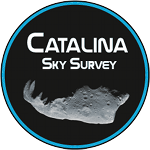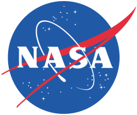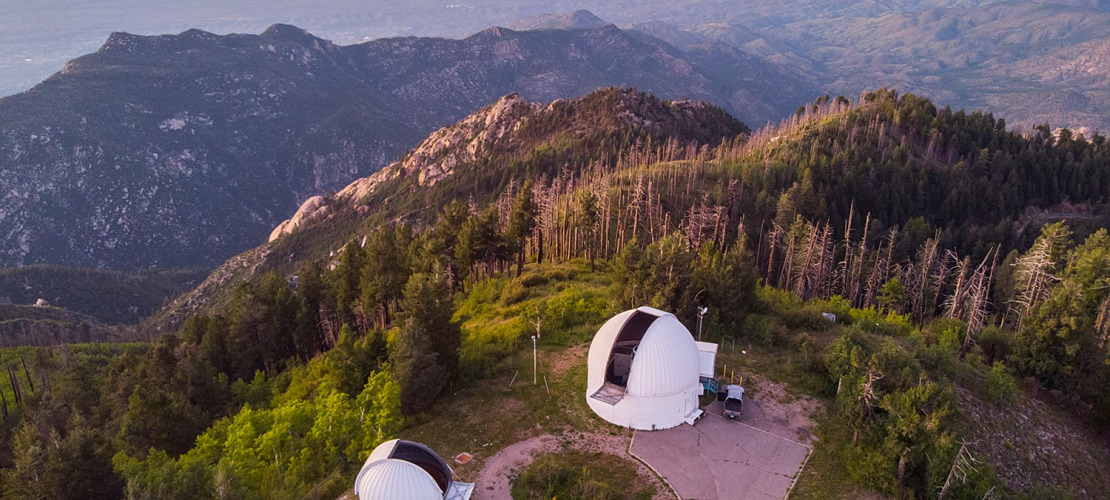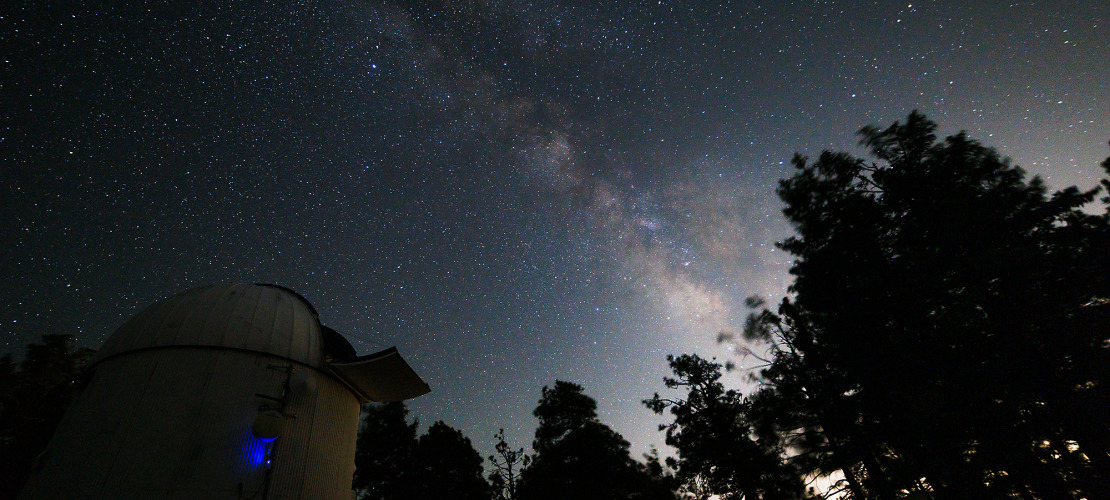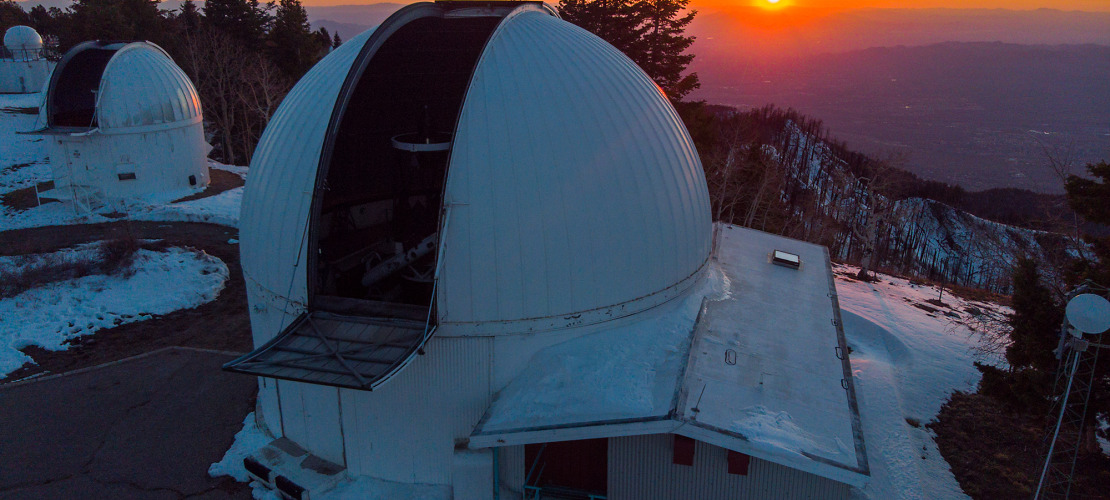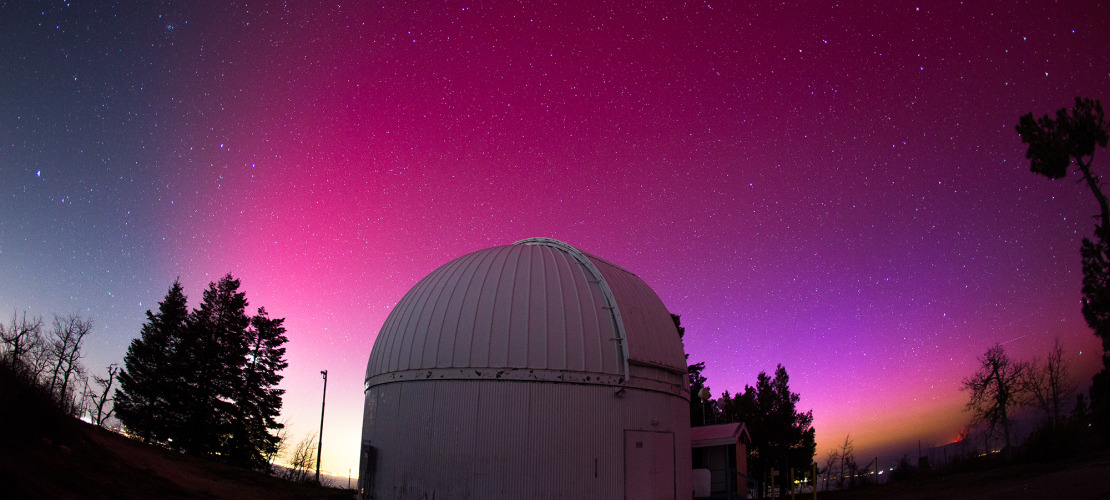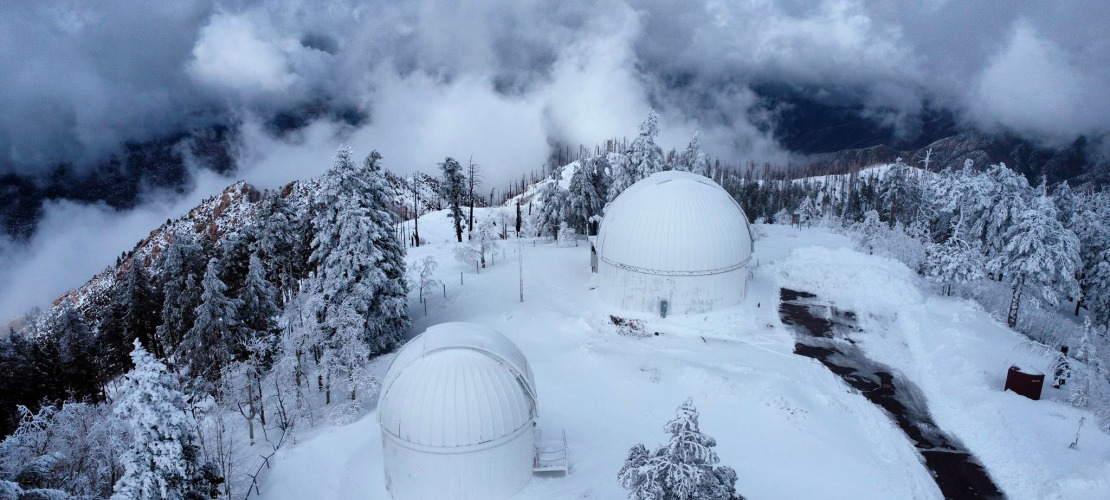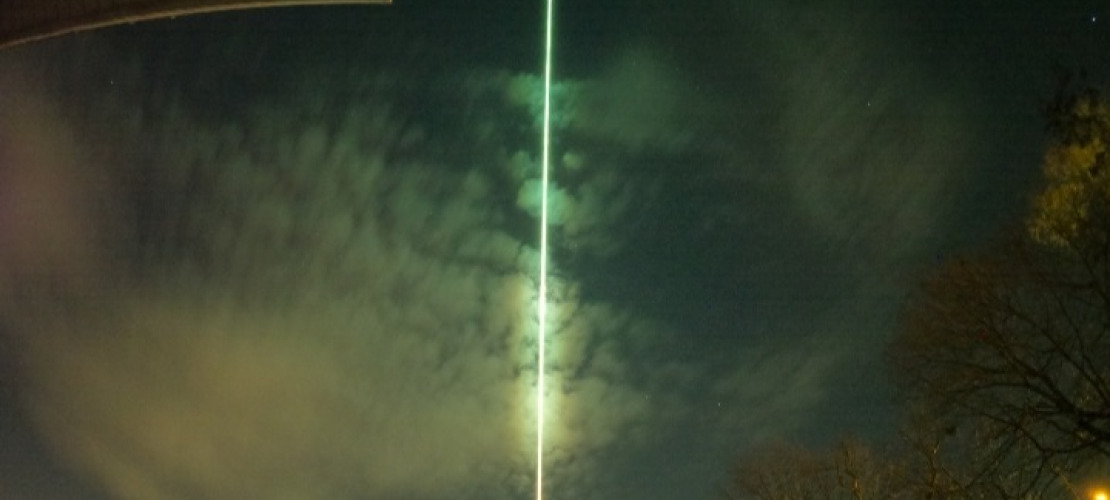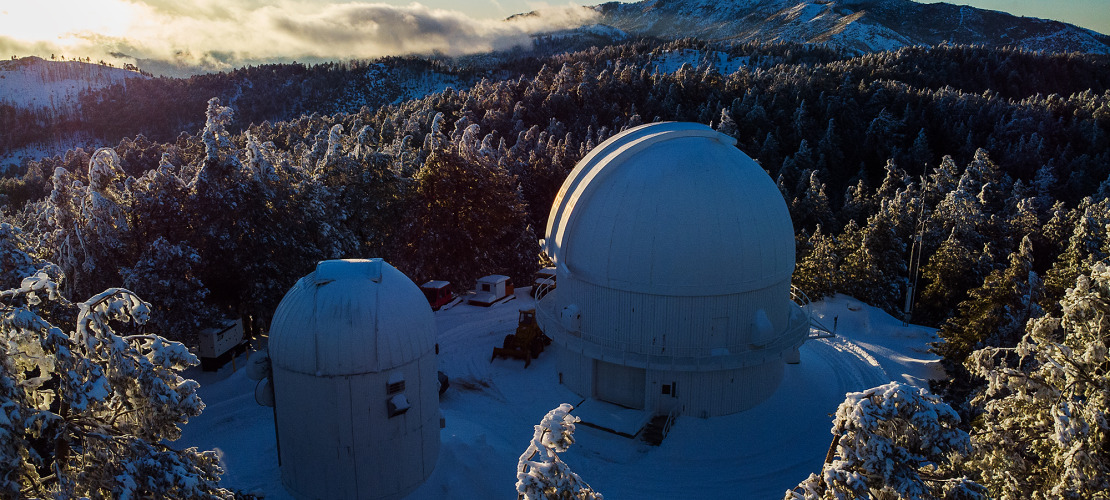ADASSx 2025
Astronomical Data Analysis Software and Systems
Summer workshop
August 1-5, 2025
Tucson, AZ, USA
Friday – Session 1 recording
Friday – Session 2 needs to be uploaded
Sunday – Session 3 recording
Sunday – Session 4 recording
Sunday – Session 5 recording
Sunday – Session 6 recording
Monday – Session 7 recording
Monday – Session 8 recording
Monday – Sessions 9 & 10 recording
Monday – Colloquium recording
Tuesday – Session 11 recording
Tuesday – Session 12 recording
Tuesday – Session 13 recording
The ADASS Program Organizing Committee (POC) is partnering with the Catalina Sky Survey (CSS), NOIRLab, the Lunar and Planetary Laboratory (LPL), Steward Observatory, and Rubin Observatory to organize a “mini-ADASS” conference to be held in Tucson, AZ. The meeting will follow the annual Rubin Community Workshop (RCW) being held July 28-Aug 1, 2025, and will feature special-topic workshops, tours, and splinter sessions in addition to the plenary meeting.
As the only ADASS event scheduled to be in the US for the next several years, we will provide a forum for participants who cannot easily attend the main ADASS meeting in the Fall. The ADASSx 2025 program will include plenary talks, posters, software demonstrations, and opportunities for attendees to organize topical interest sessions. These activities aim to stimulate further development of software and systems to meet the data science challenges of astronomy. Remote attendance will be supported. Themes include:
Time-domain Astronomy
Planetary Defense
Community Infrastructure
Pipelines and Archives
Other software topics of broad interest
All ADASSx sessions will be held in room 308 of the Kuiper Space Sciences building on the campus of the University of Arizona. Enter from the south side of the building facing the UA Mall, take the stairs or elevator to the third floor, and proceed to the atrium on the north side of the building. See the Parking tab below, or take the free Tucson Streetcar, which has a stop just one block north.
Larger-scale maps: Campus and Google
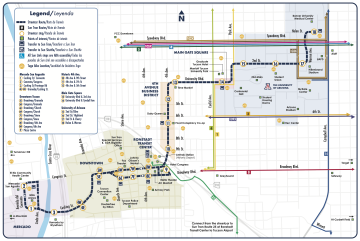
Sun Link Streetcar Map
The ADASSx Opening Reception will be on Friday, August 1, 2025, from 6:00 - 9:00 p.m. at Gentle Ben's Brewing Company in the University of Arizona's Main Gate Square district. Gentle Ben's (#14 on the map) is located in the same block as the University Marriott and is just three stops from the Kuiper Space Sciences building (#17) on the Sun Link Streetcar.
If you're feeling hydrated, stroll through the Arizona Scale Model Solar System after the Friday science sessions. The Sun and the inner solar system are in front of the Kuiper building, with Pluto and the Kuiper Belt just past Gentle Ben's. On the other hand, the Streetcar and all public transportation in Tucson are free.
Food, friends, fun and entertainment are also free. There will be a cash bar.
| Daily Schedule | ||
| August 1 | Friday | Conference opens following the Rubin Workshop |
| August 2 | Saturday | Catalina Sky Survey tours |
| August 3 | Sunday | CSS Planetary Defense Workshop |
| August 4-5 | Mon-Tue | Main meeting, plenary talks & additional sessions |
Daily highlights
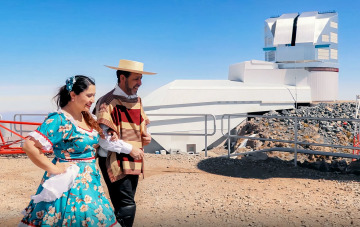
After many years of sustained effort, the Vera Rubin Observatory is poised to begin the Legacy Survey of Space and Time. Wrangling such a large investment of time from so many people required first building a strong scientific foundation. The four pillars upon which Rubin Science stands are:
Creating an inventory of the Solar System (SSSC)
Exploring objects that change position or brightness over time (TVS)
Mapping the Milky Way (SMWLV)
Understanding the nature of dark matter and dark energy (DESC, AGN, GSC, SLSC)
Each of these general scientific goals is associated with one or more Rubin Science Collaborations: "Independent, worldwide communities of scientists, self-organized into collaborations based on their research interests and expertise."
Friday's program at ADASSx features four overview talks, ranging from nearby objects and rapidly changing phenomena to the distant, majestically evolving universe. ADASSx is a software workshop, but no additional effort is needed to build such a program, since modern astronomy and planetary science pivot on the fulcrum of software.
Why Software is Eating the Small Body World – Mario Jurić
Software development for Rubin Transients and Variable Star Science – Rachel Street
Key Science Drivers of Software Development in the Stars, Milky Way, and Local Volume LSST Science Collaboration – Tom J. Wilson
The DESC and the Rubin Software and Data Ecosystem – Gautham Narayan

Sun Link Streetcar Map
The ADASSx Opening Reception will be on Friday, August 1, 2025, from 6:00 - 9:00 p.m. at Gentle Ben's Brewing Company in the University of Arizona's Main Gate Square district. Gentle Ben's (#14 on the map) is located in the same block as the University Marriott and is just three stops from the Kuiper Space Sciences building (#17) on the Sun Link Streetcar.
If you're feeling hydrated, stroll through the Arizona Scale Model Solar System after the Friday science sessions. The Sun and the inner solar system are in front of the Kuiper building, with Pluto and the Kuiper Belt just past Gentle Ben's. On the other hand, the Streetcar and all public transportation in Tucson are free.
Food, friends, fun and entertainment are also free. There will be a cash bar.
The Catalina Sky Survey telescopes reach an altitude of 9,200 feet (2,800 meters) and require traversing unpaved mountain roads. Steward Observatory requests that all tour participants sign a waiver. Please print and complete this form in advance to save time during the tour (but we'll also have clipboards and pens).
Special events for ADASSx 2025 will include a tour on Saturday, August 2nd, of the Catalina Sky Survey facilities on Mount Lemmon in the Santa Catalina Mountains north of Tucson. The CSS 60" survey telescope has discovered more than 12,000 near-Earth Asteroids, hundreds of comets (including many near-Earth comets), five small impactors, and two mini-moons. The 40" telescope next door dominates rapid astrometric follow-up of candidate NEAs, as well as second apparition recovery of known NEAs with poorly known orbits.
Coordinated operations between these two telescopes, as well as our wide-field Schmidt telescope and the deep-field Kuiper telescope on neighboring Mount Bigelow relies on diverse software tools such as CSS's NEOfixer targeting broker, which ranks the priority and the exposure cost (not just for CSS telescopes, but for many others in the community) for the growing catalog of ever-shifting NEOs and the constantly fluctuating list of NEO candidates.
Nightly astrometric measurements, images, catalogs, and other data products flow automatically to the IAU Minor Planet Center and the Small Bodies Node of the Planetary Data Center, funded by NASA's Planetary Defense Coordination Office.
Catalina Sky Survey holds its annual Monsoon Workshop during the summer shutdown in Arizona. Over several previous years, CSS has been grateful for the participation of Spacewatch and other colleagues at the Lunar and Planetary Laboratory (LPL) of the University of Arizona. Last year, we added a day of hybrid talks from the broader NEO community and Planetary Defenders everywhere.
In 2025, the Monsoon Workshop will be jointly held with the ADASSx Software Workshop following the Rubin Community Workshop. The two-day planetary defense activities will include a tour of the CSS telescopes on Mount Lemmon on Saturday, August 2, 2025, followed by workshop presentations on Sunday, August 3, at LPL on the campus of the University of Arizona. The schedule will be similar to last year, with four ~ 1.5-hour sessions and open discussions following each session. A final agenda with additional details will be released as the workshop nears.
Use the same portals as ADASSx for (free) registration and abstract submission. Planetary Defense topics with a software emphasis are also welcome during the plenary ADASSx sessions on Monday/Tuesday, August 4-5.
Send questions to rseaman@arizona.edu.
Open-source solutions for satellite constellation interference detection, quantification, and mitigation (IAU CPS)
Satellite interference is a shared challenge across both optical and radio astronomy. Open-source tools play a key role in mitigation efforts, but they’re not always easy to find, adapt, or build on.
This session brings together the optical and radio communities via SatHub at the IAU CPS to highlight practical, open-source approaches to detecting and modeling satellite signals, plus mitigating their impact on observations when possible. We'll begin with two brief talks—one from each domain—to frame the problem space and highlight some current projects, followed by a set of short invited presentations. The second part will focus on discussion and questions, aimed at identifying common needs, surfacing existing tools, and exploring opportunities for collaboration.
Links to current projects:
SatChecker – (https://github.com/iausathub/satchecker)
SCORE – Satellite Constellation Observation Repository (https://github.com/iausathub/score)
SOPP – Satellite Orbit Prediction Processor (https://github.com/NSF-Swift/satellite-overhead/)
1. A new Plotly-dash based query infrastructure for the Keck Observatory Archive
The Keck Observatory Archive (KOA) curates records of over 100 million observations acquired by the 13 instruments (11 active, 2 retired) operating at the W. M. Keck Observatory, and the archive is expected to grow rapidly as complex new instruments will soon be commissioned and as the expectations of archive users have expanded. In response, KOA has been deploying new Python based infrastructure. We have deployed real time ingestion of newly acquired data, and a dedicated interface for observers to manage these newly acquired data. We have been developing a new fast python-based VO-compliant query infrastructure. Our poster at ADASS 2024 identified the technologies chosen: Plotly-Dash, a low-code framework that exploits event-driven callbacks to simplify the handling of user interactions; R-tree spatial indexing to speedup spatial searches by x20; a VO-compliant TAP middleware, used already at the NASA Exoplanet Archive and the NEID archive; and mViewer, a visualization engine in the Montage Image Mosaic toolkit that is optimized for astronomy images.
These technologies will underpin new services that can be hosted on web pages or in Jupyter notebooks, and when completed, will replace the current query infrastructure. We have completed two new, fully functional interfaces that are in beta release. One is the Data Discovery Service, a web-based dashboard which queries the entire archive in seconds, and supports filtering observations by keywords, previewing results in a interactive data grid, visualizing images, and downloading raw, quicklook reduced and pipeline reduced data. The second is a Jupyter notebook that demonstrates how use CDS Vizier to create a list of protostars in the Rho Oph dark cloud, discover which Keck instruments have observations of them, and overlay the positions of the observations on an image downloaded from IRSA of Rho Oph, measured with the Infrared Array Camera.
This presentation describes the design of these services, and gives demonstrations of them in operation.
2. NEOfixer: How To Use the Web Site and API, How it Aids Coordination, and Other Uses
We will demonstrate how to use NEOfixer for various specific purposes and review features you may not be aware of. We will cover manual use of the web page and automated use of the API. This tutorial will show how to find the best targets for you, update your targets, report your observing status, and view the status of other observers. Examples will range from finding a single target to do now, to finding targets for a night, to finding targets that meet specific requirements. Questions will be encouraged.

3. Detect, Identify, and Measure Asteroids, Comets, and Artificial Satellites with Tycho Tracker
The Tycho Tracker software has evolved since its development began in 2018. The latest version supports measuring asteroids, comets, variable stars, and artificial satellites. In this session, we will examine several examples of how to use the Tycho Tracker software for the detection and measurement of asteroids, comets, and artificial satellites.
Discovery: How to use synthetic tracking for blind search.
Recovery: How to use synthetic tracking to recover objects.
Asteroid Photometry: Using the light curve module to generate time-series photometry of asteroids, and determine rotation period.
Comet Photometry: Using the new comet photometry module to compute Afrho value for comets and generate measurements in ICQ format.
Artificial satellites: Detection, identification, and measurement using the new FAST Tracker module.
The Search for the Most Distant Galaxies
Marcia Rieke
University of Arizona Steward Observatory, Regents Professor of Astronomy
The James Webb Space Telescope was called the "First Light Machine" when it was being studied as a potential NASA mission. It quickly became obvious that it would be impossible to prove that the "first" galaxy had been seen, but much more promising was looking for the most distant galaxies possible. This goal led astronomers to design a suite of instruments for the telescope that are optimized for looking for very faint galaxies at infrared wavelengths -- infrared is required because the expansion of the Universe moves the ultraviolet-visible output of galaxies to longer wavelengths. We have succeeded at finding galaxies seen at an age of less than 300 million years after the Big Bang. Such distant galaxies are proving to have unexpected properties which challenge our ideas of how stars formed in these first galaxies.
There is no charge for the Monsoon Workshop Banquet, which will be held at the Flandrau Planetarium on Monday evening, August 4. Flandrau is located next door to the Kuiper Space Sciences building. The doors will open at 6:00 pm, and a Mediterranean buffet will be served from 6:30 onward.
The doors of the Planetarium theater will be open throughout, with content reaching from near-Earth space to the distant Cosmos, ending the evening with a classic laser rock show (which may make up for not serving alcohol). Flandrau exhibits stretch across two floors, though, alas!, the asteroid is being refurbished. You will enter and exit through the little gift shop, which will be open for the benefit of parents suffering from guilt for leaving their children at home.
CLICK HERE FOR BANQUET TICKETS
Exploring big data efficiently with SPARCL and the Astro Data Lab science platform
In the era of data-intensive research the astronomy community needs to acquire skills to handle increasingly larger and more complex datasets, and to gain access to high-performance computing and analysis tools. In this tutorial we will teach participants how to use data-proximate science platforms to conduct astronomy research. Using the Astro Data Lab science platform and the SPARCL (SPectra Analysis and Retrievable Catalog Lab) service for spectroscopy, participants will learn how to find documentation, information about all of Astro Data Lab's data holdings of over 100 TB of wide-field survey catalogs, 2.5 PB of imagery, and over 30 million spectra from the Dark Energy Spectroscopic Instrument (DESI) and the Sloan Digital Sky Survey (SDSS).
The event will feature the record-breaking optical spectroscopy dataset DESI DR1 released in March 2025. We will teach the group in an interactive mode how to use various data services and analysis tools at Astro Data Lab, including how to crossmatch tables, build and submit catalog queries, obtain image cutouts, search for and download spectra, and how to use the Astro Data Lab Jupyter notebook server. The participants will execute and modify science-case example notebooks from various domains of astronomy focusing on data analysis, with assistance available from Astro Data Lab and SPARCL personnel.
This session is open to all interested ADASSx attendees. Participants wishing to follow along interactively are invited to bring a laptop and create an Astro Data Lab user account.
Primary learning objectives:
Construct SQL queries to query large datasets through a dedicated Jupyter Notebook server, web-interface, and command-line interface
Use Astro Data Lab’s X-match web service to crossmatch datasets
Discover and query for SDSS and DESI spectra with SPARCL
Create plots with the data obtained to realize the graphical and visualization capabilities within our notebooks
Coarse tutorial structure:
Brief introductory presentation on astronomy science platforms showcasing SPARCL and the Astro Data Lab science platform and how they can be utilized to explore, discover, and analyze data easily and efficiently
Hands-on tutorial of using SPARCL and Astro Data Lab
Using our X-match web interface service to crossmatch with the new DESI DR1 dataset (including a provided test user table, or optionally users can bring their own data table)
Hands-on exercises using available Jupyter notebooks as a starting point, including:
Using SPARCL to retrieve spectra and Data Lab to retrieve images;
Both static and interactive visualization of spectra and images;
Example analysis from catalog data (varied topics)
Remaining time for Q&A, troubleshooting, discussion and/or feature requests, etc
A Mexican lunch buffet will be served in the atrium of the Kuiper Space Sciences Building.
A scientifically insightful motion picture will be shown in the Gerard P. Kuiper Theatre of the Lunar and Planetary Laboratory.
Coordinating Spectroscopic Data Reduction and Analysis Tools
The software ecosystem for astronomical spectroscopy is in a transition period. Since 2023, an informal group of spectroscopy software developers and scientists (SpectroscopyDev) have been meeting regularly to coordinate activities and discuss developments in the field. This group is an outcome of the meeting Coordinating the Next Generation of Spectroscopic Processing and Analysis Tools, November 2023, which itself was an outcome of the Future of Astronomical Data Infrastructure, February 2023, also known as the Flatiron Meeting.
We include developers of multi-instrument reduction packages such as PypeIt, specutils, and specreduce, as well as more instrument-specific packages such as DRAGONS for Gemini and the desispec for DESI. In addition to coordinating software development, we are also documenting a common set of terms to assist with cross-project communication.
We invite the entire community to participate in more detailed descriptions of our activities, provide feedback, and assist in future planning.
Workshop details
Upload your presentations
Speakers should provide their presentations before Thursday, July 31, 2025 in Powerpoint, PDF, or Keynote format. Please upload your files to Pretalx under your login. Each abstract has a blue "Add another resource" button at the bottom of the page. Otherwise, email the files to rseaman@arizona.edu. And if that doesn't work, email the same address and we'll make alternate arrangements.
You will also be able to present from your own laptop by logging into the workshop Zoom session (details to be provided later) and sharing your screen. The copy you upload will then be a backup should there be issues sharing.
We will make presentations and Zoom recordings available on this website after the workshop, unless you opt out. Session recordings will also be posted to the LPL YouTube channel for the benefit of attendees in distant timezones. We do not yet know the latency for doing so.
All ADASSx plenary sessions will be held in room 308 of the Kuiper Space Sciences building on the campus of the University of Arizona. Enter from the south side of the building facing the UA Mall, take the stairs or elevator to the third floor, and proceed to the atrium on the north side of the building. See the Parking tab below, or take the free Tucson Streetcar, which has a stop just one block north.
Secondary group discussions can occur at the tables in the atrium, or in the smaller lecture hall next door if a projector is needed. There is also a lab space around the corner. Speak to somebody with a red lanyard for details.
See the workshop Schedule, abstracts, and uploaded content on Pretalx.
ADASSx 2025 list of registered participants click here to register
| ATTENDING | DAYS | NAME | INSTITUTION | TELESCOPE CODES | ||
| online | FSSMT | Mike | Alexandersen | Center for Astrophysics | Harvard & Smithsonian | 310 T14 | 1 |
| online | F__MT | Abhijeet | Anand | Lawrence Berkeley National Lab | 2 | |
| online | FSSMT | Tonima Tasnim | Ananna | Wayne State University | 3 | |
| online | FSSMT | Radu | Anghel | Liceul "Grigore Antipa" Bacău, Romania | M35 | 4 |
| online | FSSMT | Simon | Anghel | Paris Observatory / Astronomical Institute of the Romanian Academy | 5 | |
| in-person | FSSMT | Naman | Bajaj | Lunar and Planetary Laboratory / University of Arizona | 6 | |
| in-person | F__MT | Bellamy | Bailey | University of Arizona | 7 | |
| online | FSSMT | Daniel | Bamberger | Northolt Branch Observatories | Z80 | 8 |
| online | FSSMT | James | Bauer | University of Maryland | 9 | |
| online | _SS__ | Lance | Benner | JPL/Caltech | 10 | |
| online | _SSMT | Bruce | Berriman | Caltech/IPAC-NExScI | X05 | 11 |
| LOC | FSSMT | Tracie | Beuden | Lunar and Planetary Laboratory / Catalina Sky Survey | G96 703 I52 V06 V00 | 12 |
| online | FSSMT | Tanmoy | Bhowmik | Shahjalal University of Science and Technology | 13 | |
| in-person | FSS__ | John | Blakeslee | NSF NOIRLab | 695 807 I11 T15 X05 | 14 |
| in-person | FSSMT | Bryce | Bolin | Eureka Scientific | I41 | 15 |
| online | FSSMT | Eliud | Bonilla | Johns Hopkins University Applied Physics Laboratory | 16 | |
| in-person | FSSMT | Terry | Bressi | Lunar and Planetary Laboratory / Spacewatch | 291 691 V00 | 17 |
| online | FSSMT | John W. | Briggs | FOAH Observatory | V23 | 18 |
| in-person | FSSMT | Melissa | Brucker | Lunar and Planetary Laboratory / Spacewatch | 291 691 V00 | 19 |
| online | FSSMT | Luca | Buzzi | Società Astronomica G.V.Schiaparelli OdV | 204 | 20 |
| online | ___MT | Juan L. | Cano | ESA | 21 | |
| LOC | FSSMT | Vivian | Carvajal | Lunar and Planetary Laboratory / Catalina Sky Survey | G96 703 I52 V06 V00 | 22 |
| online | FSSMT | N | Casale | Center for Astrophysics | Harvard & Smithsonian | 23 | |
| in-person | FSSMT | Chi-kwan | Chan | The University of Arizona | 24 | |
| in-person | FSSMT | Qifeng | Cheng | Duke University | 25 | |
| online | F__MT | Brian | Cherinka | Space Telescope Science Institute | 250 274 | 26 |
| online | _SS__ | Jana | Chesley | NASA Jet Propulsion Laboratory | 673 | 27 |
| online | FSSMT | Steven | Chesley | JPL | 28 | |
| in-person | FSS__ | Hyejeon | Cho | Yonsei University | 29 | |
| online | ___MT | Max | Chong | Stellenbosch University, University of Groningen | 30 | |
| online | FSSMT | Shvetha | Chynoweth | San Francisco State University | 31 | |
| in-person | F____ | Richard | Cloete | Harvard University | X05 | 32 |
| online | FSSMT | Wilians | Conde | Mackenzie Presbyterian University | 33 | |
| online | F__MT | Simon | Conseil | CNRS/IN2P3, IP2I Lyon | 273 | 34 |
| online | F__MT | David | Cook | Caltech/IPAC | 35 | |
| in-person | ___MT | Christopher | Corbally | Vatican Observatory | 290 | 36 |
| online | FSSMT | Guido | Cupani | INAF-OATs | 37 | |
| online | FSSMT | Luiz | da Costa | Laboratório Interinstitucional de e-Astronomia | 38 | |
| online | F__MT | Malcolm | Currie | RALSpace, UK | 39 | |
| in-person | FSSMT | Michelle | Dadighat | NSF NOIRLab | 40 | |
| LOC | FSSMT | Phil | Daly | Steward Observatory | 41 | |
| online | ___MT | David | DeBoer | University of California | 42 | |
| in-person | FSSMT | Melissa | DeLucchi | LINCC Frameworks - Carnegie Mellon University | 43 | |
| in-person | _SSMT | Larry | Denneau | University of Hawaii / ATLAS | T05 T08 M22 W68 R17 | 44 |
| online | FSSMT | Maxime | Devogele | ESA Near-Earth Objects Coordination Center | 45 | |
| in-person | FSSMT | Stephen | Dilley | University of Arizona | 46 | |
| online | FSSMT | Gemma | Domènech Rams | Montsec Observatory / Institute of Space Studies of Catalonia | 47 | |
| online | FSSMT | Catalin Ioan | Doroftei | Universitatea Gh Asachi | 369 | 48 |
| online | FSSMT | Rosemary | Dorsey | University of Helsinki | 49 | |
| online | FSSMT | Charlie | Drury | ESA | 50 | |
| online | _SSMT | Siegfried | Eggl | University of Illinois Urbana Champaign | X05 | 51 |
| online | ___MT | Yash | Ejjagiri | University of Illinois Urbana Champaign | X05 | 52 |
| online | FSSMT | Rasha | Eldaly | National Research Institute of Astronomy and Geophysics (NRIAG) | 53 | |
| in-person | FSSMT | Ben | Engebreth | Independent Researcher | 54 | |
| in-person | FSSMT | John | Fairlamb | University of Hawai'I / Pan-STARRS | F51 F52 | 55 |
| in-person | FSSMT | Emilio | Falco | DarkSky International, SoAZ Chapter | 56 | |
| online | _SS__ | Kelly | Fast | NASA Headquarters | 57 | |
| in-person | _SS__ | Jacqueline | Fazekas | Lunar and Planetary Laboratory / Catalina Sky Survey | G96 703 I52 V06 V00 | 58 |
| in-person | FSSMT | Maryann Benny | Fernandes | Duke University | 59 | |
| in-person | ___MT | Tony | Ferro | University of Arizona/LPL | 60 | |
| POC chair | FSSMT | Michael | Fitzpatrick | NSF NOIRLab | 695 807 I11 T15 X05 | 61 |
| online | F__MT | Jaime | Forero-Romero | Universidad de los Andes | 62 | |
| in-person | ___MT | Noah | Franz | University of Arizona/Steward Observatory | 63 | |
| online | F__MT | Paolo | Franzetti | INAF - IASF Milano | 64 | |
| MW chair | FSSMT | Carson | Fuls | Lunar and Planetary Laboratory / Catalina Sky Survey | G96 703 I52 V06 V00 G84 | 65 |
| in-person | FSSMT | Paul | Gabor | Vatican Observatory | 290 | 66 |
| online | FSSMT | Anmol | Gandhi | Independent Researcher | 67 | |
| online | ___MT | Pedro | García-Lario | ESA/ESAC | 68 | |
| online | FSSMT | Humberto Alfonso | García Montano | Centro de Investigación de Astrofísica y Ciencias Espaciales, CIACE UNAN-Managua | X05 | 69 |
| online | F__MT | Francesco | Gianotto | ESA PDO-NEOCC | 70 | |
| in-person | FSSMT | Alex | Gibbs | Lunar and Planetary Laboratory / Catalina Sky Survey | G96 703 I52 V06 V00 | 71 |
| in-person | ___MT | Kevin | Gifford | University of Colorado Boulder | 72 | |
| online | _SS__ | Dathon | Golish | University of Arizona | 73 | |
| online | FSSMT | Steven | Gough-Kelly | University of Central Lancashire | 74 | |
| in-person | _SS__ | John T. | Grage | Mind's Eye Observatory | W42 | 75 |
| online | ___MT | Matthew | Graham | California Institute of Technology / ZTF | I41 | 76 |
| in-person | F____ | Melissa | Graham | University of Washington | X05 | 77 |
| in-person | _SSMT | Al | Grauer | Lunar and Planetary Laboratory / Catalina Sky Survey | G96 703 I52 V06 V00 | 78 |
| in-person | FSSMT | Bill | Gray | Project Pluto | 79 | |
| online | FSSMT | Sarah | Greenstreet | NSF NOIRLab/Rubin Observatory | X05 | 80 |
| online | FSSMT | Hannes | Groeller | Lunar and Planetary Laboratory / Catalina Sky Survey | G96 703 I52 V06 V00 | 81 |
| online | FSSMT | Jo | Hayashi | W. M. Keck Observatory | 82 | |
| in-person | ___MT | Gregory | Hellbourg | California Institute of Technology | 83 | |
| in-person | FSSMT | David | Herrera | NSF NOIRLab | 695 807 I11 T15 X05 | 84 |
| in-person | FSSMT | CeeCee | Hill | Lunar and Planetary Laboratory / University of Arizona | 85 | |
| online | ___MT | Kevin | Hills | Tacande Observatory | J22 | 86 |
| in-person | FSSMT | Bhavya | Hingorani | University of Arizona | 87 | |
| LOC | FSSMT | Joshua | Hogan | Lunar and Planetary Laboratory / Catalina Sky Survey | G96 703 I52 V06 V00 | 88 |
| online | FSSMT | Robert | Holmes | Astronomical Research Institute | H21 | 89 |
| online | FSSMT | Derek | Homeier | Aperio Software Ltd.; Astropy Project | 90 | |
| in-person | F____ | Jonathan | Hong | University of Arizona | 91 | |
| online | FSSMT | Mark | Huber | University of Hawai'I / Pan-STARRS | F51 F52 | 92 |
| in-person | FSSMT | Gary | Hug | Farpoint Observatory and Sandlot Observatory | 734 H36 | 93 |
| in-person | FSSMT | Anna | Hunt | Fairborn Observatory | 94 | |
| in-person | _SS__ | Jiyoon | Hur | TBD | X05 | 95 |
| in-person | __SMT | David | Iadevaia | Mountain View Observatory (MVO) | 96 | |
| online | FSSMT | Bryan | Irby | NASA GSFC | 97 | |
| in-person | ___MT | Alice | Jacques | NSF NOIRLab | 695 807 I11 T15 X05 | 98 |
| online | FSSMT | Cristovao | Jacques | SONEAR Observatory | Y05 | 99 |
| online | FSSMT | Tess | Jaffe | NASA/GSFC/HEASARC | 100 | |
| online | FSSMT | Jost | Jahn | Sternwarte Amrum | C95 M58 Q62 X06 | 101 |
| online | FSSMT | Nayan | Jangid | University of Illinois Urbana-Champaign | 102 | |
| online | FSSMT | Youngmin | JeongAhn | Korea Astronomy and Space Science Institute | W93 | 103 |
| online | FSSMT | Vivek Kumar | Jha | NCRA-TIFR, India | 104 | |
| in-person | FSSMT | Chris | Johnson | Steward Observatory | 105 | |
| online | FSSMT | Emmanuel | Joliet | Caltech | 106 | |
| online | FSSMT | Lynne | Jones | Rubin/Aerotek | X05 | 107 |
| in-person | F__MT | Stephanie | Juneau | NSF NOIRLab | 695 807 I11 T15 X05 | 108 |
| in-person | FSS__ | Mario | Jurić | University of Washington | X05 | 109 |
| online | FSSMT | Atousa | Kalantari | Institute for Advanced Studies in Basic Sciences | 110 | |
| online | FSSMT | Yijung | Kang | Rubin Observatory/SLAC | X05 | 111 |
| online | FSSMT | Chrisphin | Karthick | Indian Institute of Astrophysics | 112 | |
| online | ___MT | Fatoumata | Kebe | Bamako University | 113 | |
| online | F__MT | Heather | Kelly | SLAC | X05 | 114 |
| in-person | FSSMT | Michael | Kelley | University of Maryland | 115 | |
| online | FSSMT | Ahmed Mubbashir | Khan | Personal Capacity - (Software Engineer at ESO ) | 116 | |
| online | FSSMT | Kathleen | Kiker | B612 Foundation | 117 | |
| online | FSSMT | Myung-Jin | Kim | Korea Astronomy and Space Science Institute | V15 | 118 |
| in-person | FSSMT | Marcus | King | California Institute of Technology | 119 | |
| online | FSSMT | Sladjana | Knezevic | Astronomical Observatory of Belgrade | 120 | |
| online | FSSMT | Alec | Koumjian | B612 Foundation - Asteroid Institute | 121 | |
| online | FSSMT | Nataliya | Kovalenko | JASU | 122 | |
| in-person | FSSMT | Richard | Kowalski | Lunar and Planetary Laboratory / Catalina Sky Survey | G96 703 I52 V06 V00 | 123 |
| online | FSSMT | Shui Hung | Kwok | W. M. Keck Observatory | T16 T17 | 124 |
| in-person | FSSMT | Steve | Larson | Lunar and Planetary Laboratory / Catalina Sky Survey | G96 703 I52 V06 V00 | 125 |
| in-person | FSSMT | Cindy | Lash | Sandlot Observatory | H36 | 126 |
| online | FSSMT | Pat | Lawton | University of Maryland | 127 | |
| online | ___MT | Denis | Leahy | University of Calgary | 128 | |
| in-person | FSSMT | Hee-Jae | Lee | Korea Astronomy and Space Science Institute | 129 | |
| in-person | FSSMT | Cassandra | Lejoly | Lunar and Planetary Laboratory / Spacewatch | 695 691 291 V00 W84 T16 696 | 130 |
| online | FSSMT | Lebogang | Lekganyane | Rhodes University | 131 | |
| LOC | FSSMT | Greg | Leonard | Lunar and Planetary Laboratory / Catalina Sky Survey | G96 703 I52 V06 V00 | 132 |
| online | FSSMT | Pablo | Lewin | The Maury Lewin Astronomical Observatory (AAVSO LPAC) | U76 | 133 |
| in-person | FSSMT | Yiwei | Li | The University of Arizona | 134 | |
| LOC | FSSMT | Tyler | Linder | University of California, Los Angeles | C58 807 H21 | 135 |
| online | _SS__ | Laurance | Lingvay | Caltech COO | 695 | 136 |
| in-person | FSSMT | Tim | Lister | Las Cumbres Observatory | F65 T04 T03 V37 V39 V38 W85 W86 W87 W89 W79 K91 K92 K93 L09 Q58 Q59 Q63 Q64 E10 Z31 Z24 Z21 Z17 | 137 |
| in-person | _SSMT | Cameron | Loewen | University of Arizona | 138 | |
| online | ___MT | Jeff | Mader | W. M. Keck Observatory | T16 T17 | 139 |
| in-person | FSSMT | Alex | Malz | Carnegie Mellon University | 140 | |
| online | FSSMT | Dusan | Marceta | University of Belgrade, Faculty of Mathematics, Department of Astronomy | 141 | |
| online | FSSMT | Sean | Marshall | University of Central Florida | 251 | 142 |
| in-person | _SS__ | Ron | Mastaler | Lunar and Planetary Laboratory / Spacewatch | 291 691 V00 | 143 |
| in-person | FSSMT | Kiana | McFadden | University of Arizona | 144 | |
| online | F__MT | Brian | McLean | Space Telescope Science Institute | 250 274 | 145 |
| in-person | F__MT | Bob | McMillan | Lunar and Planetary Laboratory / Spacewatch | 291 691 V00 | 146 |
| in-person | FSSMT | Brian | Merino | NSF NOIRLab | 695 807 I11 T15 X05 | 147 |
| online | _SS__ | Marco | Micheli | ESA NEO Coordination Cenrte | Z84 J04 309 others | 148 |
| in-person | F__MT | Bryan | Miller | Gemini Observatory/NSF NOIRLab | 695 807 I11 T15 X05 | 149 |
| in-person | FSSMT | Darrel | Moon | Killer Rocks Observatory | V20 | 150 |
| in-person | FSSMT | Lorraine | Moon | Killer Rocks Observatory | V20 | 151 |
| online | FSSMT | Ryan | Moore | Not Affiliated | 152 | |
| online | FSSMT | John | Mora | Inter-University Centre for Astronomy and Astrophysics (IUCAA) | 153 | |
| online | FSSMT | Carlos | Morales Socorro | Asociación Astronómica y Educativa Henrietta Swan Leavitt | 154 | |
| in-person | FSSMT | Rosemary | Moseley | Caltech | 155 | |
| online | FSSMT | Saeed | Mozaheb | Sharif University of Technology | 156 | |
| in-person | FSSMT | Chadd | Myers | NSF NOIRLab | 695 807 I11 T15 X05 | 157 |
| in-person | F____ | Gautham | Narayan | University of Illinois, Urbana-Champaign, NSF-Simons SkAI Institute | X05 | 158 |
| online | F__MT | Tobias | Neumann | JMU Würzburg | D69 | 159 |
| online | FSSMT | Thobekile | Ngwane | Stellenbosch University and the South African Astronomical Observatory | M28 | 160 |
| online | FSSMT | Robert | Nikutta | NSF NOIRLab | 695 807 I11 T15 X05 | 161 |
| online | F__MT | Ricky | Nilsson | Caltech/IPAC-NExScI | 162 | |
| in-person | FSSMT | Phillip | Noel | Steward Observatory | 163 | |
| online | F__MT | Dario | Oliviero | Deimos for ESA | 164 | |
| online | ___MT | Ricky | O'Steen | Space Telescope Science Institute | 250 274 | 165 |
| online | FSSMT | Yash | Padaya | Liverpool John Moores University | 166 | |
| in-person | FSSMT | Gregory | Paek | Institute for Astronomy | X05 | 167 |
| online | _SSMT | Daniel | Parrott | Tycho | 247 | 168 |
| online | FSSMT | Antonio | Pasqua | University of Bologna | 169 | |
| online | FSSMT | Anna | Payne | Space Telescope Science Institute | 250 274 | 170 |
| in-person | FSS__ | Matthew | Payne | Harvard & Smithsonian Center for Astrophysics, Minor Planet Center | 171 | |
| online | _SSMT | Jean-Marc | Petit | CNRS / UMLP | 568 T14 309 | 172 |
| online | FSSMT | Timothy | Pickering | MMT Observatory | 696 | 173 |
| online | FSSMT | Silvia | Piranomonte | INAF - Osservatorio Astronomico di Roma | 174 | |
| in-person | FSSMT | Natalya | Pletskova | Drexel University | 175 | |
| online | F__MT | Andy | Ptak | NASA/GSFC | 176 | |
| in-person | FSSMT | Daysi | Quinatoa | Observatorio Astronómico de Quito | X05 | 177 |
| online | FSSMT | G B | Raghavkrishna | Indian Institute of Technology Madras | 178 | |
| online | FSSMT | Yudish | Ramanjooloo | University of Hawaii - Manoa | 179 | |
| in-person | FSSMT | David | Rankin | Lunar and Planetary Laboratory / Catalina Sky Survey | G96 703 I52 V06 V00 V11 | 180 |
| in-person | FSSMT | Mike | Read | Lunar and Planetary Laboratory / Spacewatch | 291 691 V00 | 181 |
| online | FSSMT | David | Rodriguez | Space Telescope Science Institute | 250 274 | 182 |
| in-person | ___MT | Laura | Rogers | NSF NOIRLab | 695 807 I11 T15 X05 | 183 |
| online | FSSMT | Maarten | Roos-Serote | ScienceCurve.Space | 184 | |
| in-person | FSSMT | Eric | Rosas | Vera Rubin Observatory | X05 | 185 |
| online | F__MT | Regina | Rudawska | Starion Group / ESA ESTEC | 186 | |
| online | FSSMT | Ben | Rusholme | Caltech/IPAC | 187 | |
| online | ___MT | Kristin | Rutkowski | HEASARC, NASA | 188 | |
| online | _SS__ | Bill | Ryan | NM Tech/Magdalena Ridge Observatory | H01 | 189 |
| online | _SS__ | Eileen | Ryan | NM Tech/Magdalena Ridge Observatory | H01 | 190 |
| in-person | FSSMT | Rohin | Sant | University of Arizona | 191 | |
| online | FSSMT | Renaud | Savalle | Observatoire de Paris-PSL | 192 | |
| in-person | FSSMT | Christian | Schaller | Lunar and Planetary Laboratory | 193 | |
| in-person | F____ | Megan E. | Schwamb | Queen's University Belfast | X05 | 194 |
| in-person | FSSMT | James | Scotti | Lunar and Planetary Laboratory / Spacewatch | 291 691 V00 | 195 |
| LOC chair | FSSMT | Rob | Seaman | Lunar and Planetary Laboratory / Catalina Sky Survey | G96 703 I52 V06 V00 E12 | 196 |
| online | FSSMT | Patrick | Seitzer | University of Michigan | 807 | 197 |
| online | FSSMT | Tanmay | Singh | Arizona State University | 198 | |
| in-person | FSSMT | Neev | Shah | The University of Arizona | 199 | |
| online | F__MT | Nigel | Sharp | National Science Foundation | 200 | |
| in-person | FSSMT | Benjamin | Sharkey | University of Maryland | 201 | |
| online | _SS__ | Yashvi | Sharma | California Institute of Technology | 202 | |
| in-person | ___MT | Frank | Shelly | Lunar and Planetary Laboratory / Catalina Sky Survey | G96 703 I52 V06 V00 | 203 |
| online | FSSMT | Joel | Shernicoff | NSF NOIRLab | 695 807 I11 T15 X05 | 204 |
| online | FSSMT | Pravit | Shetty | Ahmedabad University | 205 | |
| online | FSSMT | Devanshi | Singh | University of Washington | 206 | |
| online | FSSMT | Robert | Siverd | Unaffiliated | 207 | |
| online | FSSMT | Warren | Skidmore | NASA IRTF, University of Hawaii | 208 | |
| in-person | FSSMT | Yatrik | Solanki | Harvard & Smithsonian Center for Astrophysics, Minor Planet Center | 209 | |
| online | FSSMT | Michael | Solontoi | Monmouth College | 210 | |
| online | ___MT | Boris | Sorokin | SKAO | 211 | |
| online | FSSMT | Bringfried | Stecklum | Thueringer Landessternwarte Tautenburg | 033 | 212 |
| in-person | F____ | Wiktoria | Stefanowska | Adam Mickiewicz University | 213 | |
| online | FSSMT | Lisa | Stiller | Citizen Scientist | 214 | |
| LOC | _SSMT | Elizabeth | Stobie | Steward Observatory | 215 | |
| in-person | FSSMT | Rachel | Street | Las Cumbres Observatory | F65 T04 T03 V37 V39 V38 W85 W86 W87 W89 W79 K91 K92 K93 L09 Q58 Q59 Q63 Q64 E10 Z31 Z24 Z21 Z17 | 216 |
| online | FSSMT | Michael | Stroh | National Radio Astronomy Observatory | 217 | |
| online | _SS__ | Sharda | Subramanian | Personal Capacity | 218 | |
| in-person | FSSMT | Sarah | Sutton | University of Arizona | 219 | |
| online | FSSMT | Teerasak | Thaluang | Akin Observatory | O51 | 220 |
| LOC | FSSMT | Adam | Thornton | NSF/DOE Rubin Observatory | X05 | 221 |
| online | FSSMT | Eduardo | Toledo Romero | University of Edinburgh | 222 | |
| in-person | FSSMT | Hiyo | Toriumi | Shibaura Institute of Technology, JAXA ISAS | 223 | |
| online | FSSMT | Karla | Torres | Universidad Nacional Mayor de San Marcos | 224 | |
| in-person | _SS__ | Mark | Trueblood | Winer Observatory | 290 648 | 225 |
| in-person | FSSMT | Yi Tung | Tsang | University of Arizona | 226 | |
| in-person | FSSMT | Andrew | Tubbiolo | Lunar and Planetary Laboratory / Spacewatch | 291 691 V00 | 227 |
| online | FSSMT | Mahmud | un Nobe | Wayne State University | 228 | |
| in-person | FSSMT | Francisco | Valdes | NSF NOIRLab | 695 807 I11 T15 X05 | 229 |
| online | FSSMT | Pfesesani | van Zyl | South African Radio Astronomy Observatory | 230 | |
| online | FSSMT | Gijs | Verdoes Kleijn | Kapteyn Astronomical Institute, University of Groningen | 231 | |
| in-person | FSS__ | Peter | Vereš | Harvard & Smithsonian Center for Astrophysics, Minor Planet Center | 232 | |
| online | FSSMT | Adrien | Vilquin Barrajon | Aoraki Mackenzie International Dark Sky Reserve | R56 | 233 |
| in-person | F__MT | Kat | Volk | Planetary Science Institute | 234 | |
| online | ___MT | Willem-Jan | Vriend | Rijksuniversiteit Groningen, Kapteyn Astronomical Insititute | 235 | |
| in-person | FSSMT | Connie | Walker | IAU CPS and NSF NOIRLab | 695 807 I11 T15 X05 | 236 |
| in-person | FSSMT | Thomas Jichen | Wang | University of Pittsburgh Allegheny Observatory | 778 | 237 |
| in-person | FSSMT | Benjamin | Weaver | NSF NOIRLab | 695 807 I11 T15 X05 | 238 |
| online | _SSMT | Henry | Weiland | UH Institute for Astronomy (ATLAS) | T05 T08 W68 M22 R17 | 239 |
| online | FSSMT | Guy | Wells | Northolt Branch Observatory | Z80 | 240 |
| in-person | _SS__ | Mathew | Wells | Lunar and Planetary Laboratory | 241 | |
| online | ___MT | Kyle | Westfall | University of California Observatories | 242 | |
| online | FSSMT | Maria | Wicher | PTAstroBio / Polskie Towarzystwo Miłośników Astronomii | 243 | |
| in-person | _SSMT | Kacper | Wierzchos | Lunar and Planetary Laboratory / Catalina Sky Survey | G96 703 I52 V06 V00 G83 T15 I11 | 244 |
| in-person | FSS__ | Tom J. | Wilson | University of Exeter | X05 | 245 |
| in-person | FSSMT | Kevin | Wong | Vera Rubin Observatory | X05 | 246 |
| online | _SSM_ | Quanzhi | Ye | University of Maryland | I41 | 247 |
Please send corrections to rseaman 'at' arizona.edu
It is perhaps not widely known that Tucson was the first UNESCO City of Gastronomy designated in the United States. ADASSx attendees are encouraged to explore the Old Pueblo's many creative restaurants, whether on the list below or not.
ADASSx will provide a mid-morning coffee buffet and an afternoon snack break between sessions. Breakfast, lunch, and dinner are the attendees' choice. Many restaurants are within walking distance of the conference venue or are just a few stops away along the free Streetcar line. For those in a hurry, several quick and inexpensive options are on the second and third floors of the SUMC, steps away from the ADASSx sessions. Restaurant hours vary seasonally, so please verify that your choice is open first.
Dining reachable by walking or Streetcar falls into five general zones.
- On and near campus
- Watch out for the AI-piloted robots. I, for one, welcome our new food delivery overlords!
- Corks & Craft at the southwest corner of the "SUMC Canyon" (labeled "The Scoop" on the out-of-date map) may be the only place on campus to get carded. "Burgers, charcuterie, gourmet grilled cheese. Wine and local beers," according to Reddit.
- Staying at Aloft? Try Miss Saigon or Trident Grill.
- Couldn't reserve (or afford) a casita at the Arizona Inn? Have a cocktail on the Audubon Patio or hobnob with the plumed snowbirds in the Main Dining Room.
- Main Gate
- ADASS's opening Reception is upstairs at Gentle Ben's. If eating downstairs, we prefer sitting outside.
- Illegal Pete's – eminently edible burritos. Try the potatoes in honor of Dan Quayle, who more recently saved the Republic. Probably best to sit upstairs at this one.
- Frog and Firkin – "inventive variations on traditional English pub fare."
- Many other diverse options that change faster than my personal lunch cadence.
- Time Market is halfway between Main Gate and Fourth Avenue. The Third Avenue Streetcar stop is right outside.
- or it's a 10-minute walk from the same Streetcar stop to Zemam's, Too, authentic Ethiopian dining.
- Fourth Avenue
- Magpies is a worthy contender in the never-ending pizza wars. Pesto? Yes, please!
- The Shanty, "Arizona's Oldest Continuously Licensed Bar." There will be students.
- The Hut tiki bar. If you've been to Tucson before, you may recognize the Moʻai relocated from a mini golf course across town.
- If cultural appropriation gives you indigestion, select from many other options like the Boxyard or Bison Witches.
- Downtown
- Too many to single out, but Maynards is a favorite.
- Chimichanga aficionados should make the pilgrimage to El Charro, where they were invented.
- Borderlands Brewing Co. now has two locations and is the Tucson home for Astronomy on Tap (3rd Tuesdays).
- The AC Hotel has the...wait for it... AC Lounge. It's near the Rialto Theatre.
- The Black Jacket Symphony will perform "Hotel California" at the Rialto on Monday, November 6.
- Or pair other downtown restaurants with other events.
- For those on per diem, Metal Mondays at Club Congress are free.
- Mercado San Agustin at the end of the Streetcar line
- Agustin Kitchen is a nice place to dawdle, inside or out.
- Judging from the line always waiting, Seis Kitchen must be good. Think about ordering online, perhaps from the Streetcar on the way.
- At the Annex, we enjoy plant-based Beaut Burger.
- Pair it with a plant-based beverage from Westbound.
If you or your friends have a rental vehicle or can split an Uber:
- The LOC hesitates to pick a Mexican restaurant. Willie Nelson and William Shatner like Mi Nidito in South Tucson.
- Heading north, brunch is a bust for conference-goers, but Prep & Pastry is the place if the morning Focus Demo left you in need of a Mimosa.
- Try the patio at Blue Willow.
- The POC dinner will be at the Union Public House at Saint Philip's Plaza. If you eat there before Wednesday, let us know how it was.
- Keep going north, there are several options at La Encantada shopping center in the foothills. Frost Gelato for desert. This is also where to find the Apple Store.
- Heading east, Cielos has a pleasant patio at the Lodge on the Desert.
- Headed west, be a true rebel at Slice & Ice, which split off from the ubiquitous eegee's a few years back. Lime at one, lemon at the other.
- Wandering about in the middle, Feast has a new menu every month. Try the Halloumi grilled cheese. Open Tue-Sat. Next to SWS Computers.
- Hankering for a chain restaurant? Never fear! Tucson's Culinary Dropout is in a converted lumber yard.
- You won't have trouble finding a sports bar in Tucson, but devotees of the Church of the SubGenius might try Bob Dobbs.
- Oh! Here's the other Borderlands across the street.
- Relax at the Hop Shop with new friends and their old dogs.
- Ciao Down Pizza delivers to your table, or fetch it yourself from the food truck du jour.
- Exploring the periphery, Google thinks a Holiday Inn Express is a "resorts and casinos near me". Maybe try Apple Maps.
- Virtual Seattle: Piroshky Piroshky comes to Tucson.
Please designate a driver as needed.
Hotels listed here are either adjacent to the University of Arizona Campus or lie along the Sunlink Streetcar line which will be running without charge throughout the meeting. There is a Streetcar stop steps from the ADASS meeting venue. Attendees with automobiles have a larger set of Tucson hotel and resort options with similar travel times. Parking ($16 per day) is adjacent to the ADASS venue (or cheaper parking is a short walk away). Street parking on campus (and some lots and garages) use a parking app, which you may want to install in advance.
It can be awkward to change hotels during a conference, but it may be worth checking availability and rates separately for the Rubin Community Workshop and ADASSx, especially the weekend. Buses are free in Tucson, and Ubers are competitively priced.
Lots to do in Tucson! The ADASSx plenary meeting venue is located just outside the orbit of Saturn on the University of Arizona's Scale Model Solar System. Head out the Main Gate past Neptune for various lunch and dinner options.
On Sunday, the Catalina Sky Survey Planetary Defense Splinter Session is on Venus (at the Lunar and Planetary Laboratory). Elsewhere in the inner Solar System, an actual fragment of an asteroid is floating around the asteroid belt, the Flandrau Planetarium is for Martians, and the Moon Tree, a sycamore grown from a seed that flew on Apollo 14, lives by the model Earth and Moon.
| On campus | By trolley | Around town |
|---|---|---|
Some places to check for time-varying events happening during your visit to Tucson are:
...and just a few specific transient events happening before, during, and after ADASS:
Center for Creative Photography's 50th Anniversary
Aug. 6: Buddy Guy
| Day trips North | Day trips South |
|---|---|
| Day trips East | Day trips West |
|---|---|
Logistics have intentionally been kept simple. Address questions to anybody wearing a red lanyard.
Between the 2023 meeting and when ADASS was last in Tucson in 2006, the University of Arizona has adopted this statement:
- We respectfully acknowledge the University of Arizona is on the land and territories of Indigenous peoples. Today, Arizona is home to 22 federally recognized tribes, with Tucson being home to the O'odham and the Yaqui. Committed to diversity and inclusion, the University strives to build sustainable relationships with sovereign Native Nations and Indigenous communities through education offerings, partnerships, and community service.
The statement is new, but ADASSx 2025 will be the fifth time ADASS has been held on the land of the O'odham and Yaqui.
The process of crafting the statement in consultation with leaders of the Tohono O'odham Nation and the Pascua Yaqui Tribe was as important as its final form, and indeed, the work continues. Read more about this process from the University and from the O'odham, and visit the websites of the:
The ADASS conference series is held annually and moves from country to country and institution to institution. Many requirements of personal and professional good conduct apply to all ADASS attendees, from the hosting institutions to the international scientific, astronomical, engineering, and software organizations we variously belong to:
- ADASS CODE OF CONDUCT (2022)
- UNIVERSITY OF ARIZONA ETHICS AND CONDUCT
- IAU Code of Conduct
- AAS CODE OF ETHICS
- SPIE CODE OF CONDUCT
- IEEE CODE OF CONDUCT
- ACM CODE OF ETHICS AND PROFESSIONAL CONDUCT
If you see a problem with in-person or online behavior during ADASSx 2025, bring it to the attention of the organizers. We will be wearing the red lanyards. Or contact the POC Chair, Mike Fitzpatrick (mike.fitzpatrick@noirlab.edu) or LOC Chair, Rob Seaman (rseaman@arizona.edu).
Posters for ADASSx 2025 will be displayed from Friday to Tuesday
Poster submissions closed on July 21. Email rseaman@arizona.edu if you would like to bring a poster from the Rubin Community Workshop.
Log into Pretalx to upload the PDF version of your poster
The organizers encourage poster submissions to be provided in both physical and electronic formats to reach the widest audience. Poster authors are encouraged to submit up to four pages for the proceedings (see Author instructions below).
Physical posters
- Posters will be displayed in the atrium of the Kuiper Space Sciences building.
- First authors must register for the meeting but can attend online.
- Physical posters should fit in a one-meter square space (the boards are 4'x8' to hold two posters side-by-side).
- To play well with the posters on either side, don’t go much wider than 1.1 meters.
- You can have it hang down a bit if you really think folks will be interested enough to kneel down.
- It is the responsibility of the authors to arrange for posters to be put up.
- Push pins will be supplied.
- Poster space is first-come, first-served.
- Posters must be removed by the end of the final day. Any remaining will be discarded.
Electronic posters
- Submissions of poster PDFs are open NOW:
- We heartily encourage discussions about individual posters on the #poster channel on Slack.
- The agenda for ADASSx 2025 does not include sessions for poster presentations. A short video lightning talk can be uploaded to Pretalx.
There are several parking garages on the University of Arizona campus. Individually, the garages are straightforward to navigate. The entire parking system is complicated and uses at least four different payment models:
- take a ticket on the way in and pay at the gate on the way out
- take a ticket and snap a photo of the QR code with your phone to pay
- use a cashier (rare)
- install a parking app on your phone
The Cherry Street Garage is closest to the workshop venue at the Kuiper Space Sciences building. This uses the ticket with a QR code method.
Cost is generally $8.00 for all-day parking, with a complex heuristic ramping up to $16.00 if you lose your ticket. Press a button at the exit gate to talk to a human if needed.
The Sun Link Streetcar runs along 2nd Street and is free during ADASSx. Service is every 10-15 minutes until midnight on Friday and Saturday, until 10:00 pm on weekdays, and 20-30 minutes until 8:00 pm on Sundays. The nearest stop to the Kuiper Space Sciences building (#17) is one block directly north on the other side of NOIRLab. The nearest stop to the Friday evening reception (#14) is immediately next to the front door of Gentle Ben's. Other interesting destinations lie along 4th Avenue, and downtown Tucson, all the way to the end of the line at Mercado San Agustin.
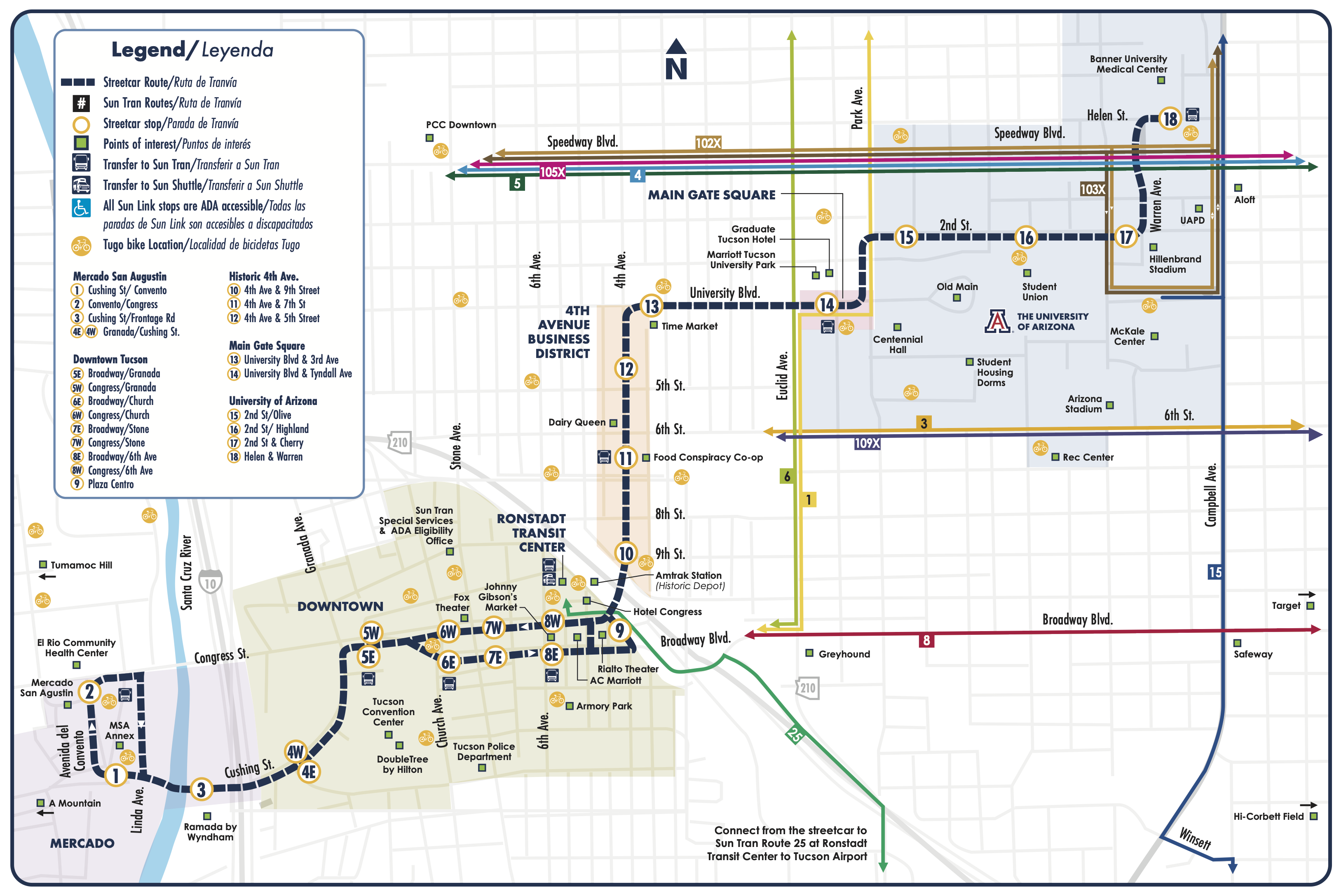
Sun Link Streetcar Map
You know what to do, or if you don't, now is a good time to find out:
The ADASSx Monsoon Workshop Zoom link will be emailed shortly before the workshop.
Consult the ADASSx agenda, all times Arizona Time (Arizona = UTC - 7 hours), for specific sessions and events of interest during daylight hours in Arizona, USA between August 1-5. Join the ADASS Zoom meeting at any point.
We will record all sessions. Individual speakers may opt out. Links to the recordings will be posted as the university's automated cloud processing allows. We also hope to host these on LPL's YouTube account.
These will be standard Zoom sessions. Please use familiar online etiquette:
- use the #session-q-and-a Slack channel to ask most questions for each session
- questions posted to the Zoom chat may result in a delay
- raise your (virtual) hand and be recognized before speaking
- mute when not speaking
The ADASSx venue has mics in the ceiling and even whispers may be audible to online participants. Please take conversations outside the room into the atrium.
ADASSx is an opportunity to be creative with your static photos, but also consider pointing your webcam at your pet snake or plug it (the camera, not the snake) into your telescope. ADASSx hopes to at least partially erase the barrier between in-person and online attendance at a hybrid meeting. A little effort from each of us may have disproportionate benefits. Examples of connecting virtual cameras to online content will be available for pinning in gallery view. This is easier to configure than it may seem, e.g., see https://obsproject.com.
Workin' on it. The conference wifi network name and password will be provided at the venue.
University IT will enable a temporary named SSID for the event in addition to eduroam and the visitor and student/staff networks. TBD whether there will be a password for the named network, but the visitor network has the familiar daily registration process used on many campuses. The goal is that everybody will use the conference's named network, but you might verify in advance if eduroam is an option for your institution and create an account as a fallback. UAGuest should be a distant third as an option (perhaps fourth after your phone as a hotspot) and appears to work better for Windows laptops. YMMV.
Wifi on campus is generally quite solid. Eduroam tested at 80 Mbps up and down with zero packet loss compared to a bit faster student/staff wifi with ~1% packet loss, presumably from the hundreds of competing connections in the building at the time. The LOC has not had an opportunity to test the venue's wifi at scale, but every lunch-hour rush downstairs likely loads the building similarly to an ADASS. The venue's mesh network itself sees little student loading.
Please practice the various public health skills we have had to learn the last few years. If recent events are a guide, some will wear masks and others will not. (I will keep one handy in a pocket.) Please be considerate of other attendees' inclinations.
The meeting and banquet venues are large spaces that permit easy social distancing. The reception includes an outdoors patio. The campus has numerous outdoor locations for your personal and professional discussions if a particular space seems too confining. (The 14-day weather forecast is "sunny and warm".) Hand sanitizer remains ubiquitous on campus.
Consider the latest booster vaccine before you travel.
Some COVID-19 links:
Local Organizing Committee (LOC)
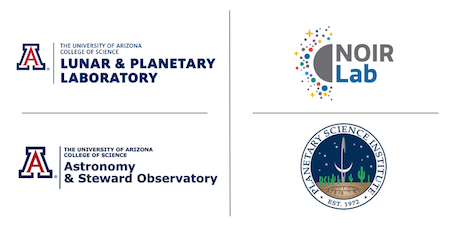
- Tracie Beuden (Catalina Sky Survey)
- Vivian Carvajal (CSS)
- Philip Daly (Steward Observatory)
- Michael Fitzpatrick (NOIRLab)
- Joshua Hogan (CSS)
- Greg Leonard (CSS)
- Tyler Linder (Planetary Science Institute)
- Rob Seaman (Chair, CSS)
- Elizabeth Stobie (Steward Observatory)
- Adam Thornton (Rubin Observatory)


